Disaster drill puts CC, Navy and Suburban partnership to the test
By Kathryn Boswell
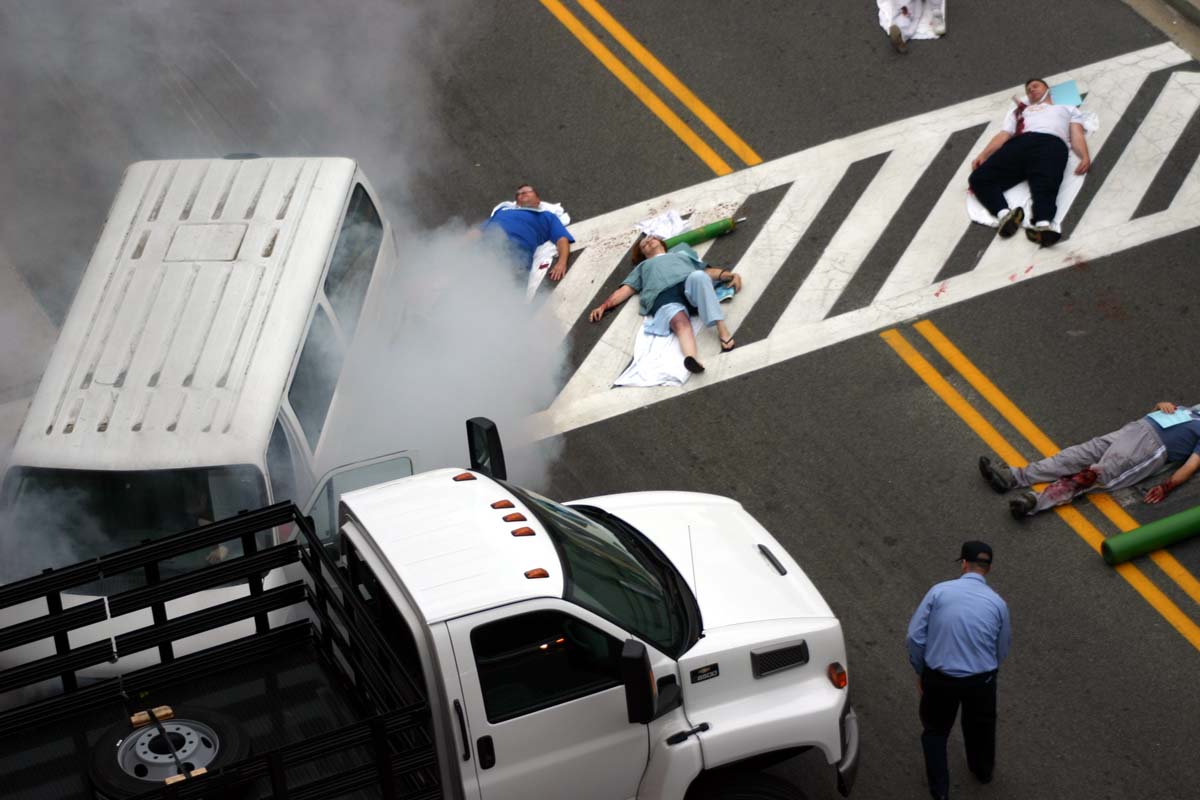 |
|
At the scene of the simulated disaster outside the Naval Medical Center, volunteers pretend to be injured by the car crash and released gases.
Photo by Svetlana York.
|
Disaster struck on Sept. 29 at the National Naval Medical Center as a passenger van ran over a group of joggers and then careened into a parked truck loaded with anhydrous ammonia. Immediately after, similar strikes—thought to be terrorist attacks—were reported around the county. At Navy, the air filled with a fog of gas that burned the victims’ eyes and skin. Thankfully, the screams from the victims and the emergency personnel on the scene were all part of an elaborate disaster-response drill designed in part to test the Emergency Preparedness Partnership composed of the NIH Clinical Center, National Naval Medical Center and Suburban Hospital.
The partnership was formalized during a ceremony earlier in the day. Dr. John I. Gallin, CC director; Rear Admiral Adam Robinson, Jr., commander of the National Naval Medical Center; and Brian Gragnolati, president and chief executive officer of Suburban Hospital Healthcare System, each signed the memorandum of understanding that links the military, federal and private-sector hospitals for streamlined integration of responses in case of disasters.
At a press conference after the ceremony, Gallin said the partnership was an important step, but that there was more work to be done. During the recent hurricanes in Florida, Louisiana and Texas, he said a major challenge was locating patients’ medical records, which in many of those areas were under water or destroyed. “There is a need for electronic patient records that could span the country—a credit card device with a person’s essential medical information they could keep in their wallet,” he added.
Also present for the signing were C.W. “Bill” Young (R-FL), chair of the House Appropriations Committee and a representative of Florida’s 10th Congressional District, and Chris Van Hollen (D-MD), representative for Montgomery County’s 8th Congressional District, where NIH is located.
This year’s disaster drill included more than 4,000 participants from Suburban Hospital, NIH, the Naval Medical Center, Montgomery County Homeland Security and county hospitals.
“The partnership we have established with National Naval Medical Center and Suburban Hospital has expanded tremendously both the Clinical Center’s and our partners’ capacities to respond to emergency situations,” said Dr. David Henderson, CC deputy director for clinical care. “The partners have developed emergency preparedness processes such as streamlined communications procedures, strategies for resource sharing, and the ability to free up beds to accommodate patients from Suburban and Navy. These preparedness drills provide us the opportunity to test, under fairly realistic circumstances, how well these newly designed processes actually work.”
In order to make the drill as real as possible, more than 70 volunteers were painted with gory makeup to give a Hollywood-style horror feel to the exercise.
Disaster victims were bused from the scene at Navy to Suburban Hospital and non-critical patients from Suburban were transferred to the Clinical Center under an established surge plan. Betty Lawrence, nursing department, greeted the victims at the transport entrance on the Hatfield Center’s west side and made notes of their conditions. Mock patients wore tags specifying their conditions throughout the exercise. Mary Sparks, nurse consultant in the CC director’s office, managed the surge area during the drill and oversaw the flow of patients. The first group included an alcoholic/detox patient, a psych patient on suicide watch and a patient suffering from strep throat and dehydration. Karen Kaczorowski, nursing’s deputy chief, ambulatory care services, transferred the patients’ registration information to a large piece of paper, noting their names, room assignment and medical condition.
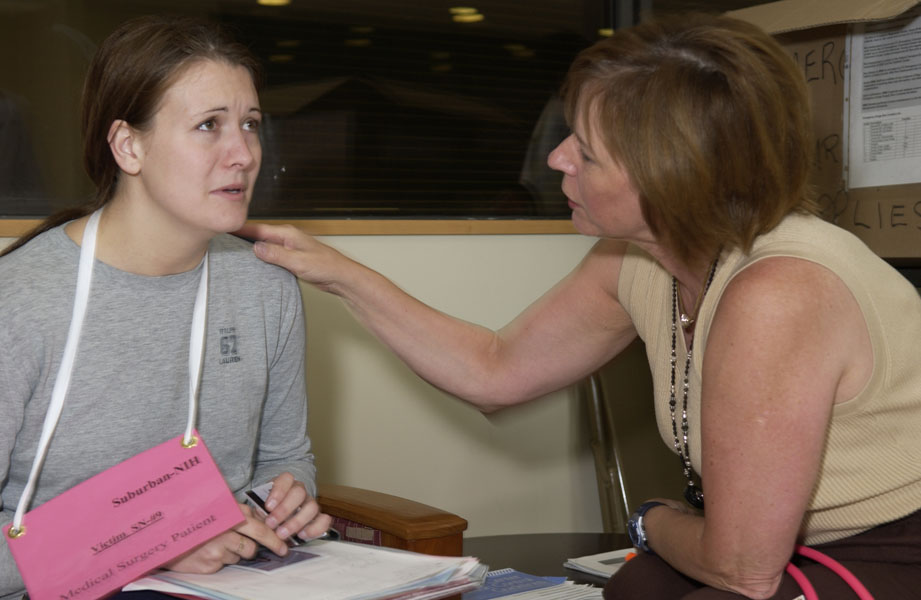 |
|
A volunteer-victim who has arrived at the Clinical Center with strep throat gets into character as she is comforted by nurse Maureen Kennedy.
|
As patients streamed in, Dr. Fred Gill, chief of the CC internal medicine consult service, noticed that the registration nurse was not wearing a mask—vital when dealing with contagious illnesses. A drill observer standing nearby noted the mask issue, adding it to a list of items that would be discussed in later debriefings. Lessons learned from the drill may prove to be critical training for future disasters—preparing everyone for the smallest detail to a large-scale need.
As a nurse prepared to escort the patient who had arrived with a “suicide-watch” noted on his file, another CC employee stepped in to point out that a petite staffer should not be left alone to escort a much larger individual who could have psychological problems. Keeping with the true-to-life scenario, NIH police officers John Coe, Michael Lake and Alan Baum were called to the scene to assist with the escort. A few minutes later, their presence became a necessity when the patient began to fight back with surprising force—requiring the strength of all three officers to restrain him and move him out of the lobby. When the officers returned to the lobby they were met with cheers from CC staff as one retrieved his shoe that had flown off in the scuffle.
Every participant in the day’s drill was focused and intense. It was serious business and everyone showed the same tension and adrenaline that could be expected from a real event. At times there would even be confusion between simulation and reality. When news of a car crash on Rockville Pike reached some of the staff, someone said, “I didn’t know about that part of the drill.” To which another responded, “No, it’s real.”
“You never know what could happen,” Kaczorowski said, smiling.
Chris Walz, editor of The Journal at the National Navy Medicine Center, contributed to this article.
Back to Top
Dr. Lynn Gerber retires from NIH
By Kathryn Boswell
At the retirement party held in honor of Dr. Lynn Gerber, her colleague Capt. Charles McGarvey held up a stack of papers with the name “Naomi Lynn Hurwitz Gerber, MD” printed at the top of the first page. “This is a 19-page, single spaced curriculum vitae,” he began. “And there is not a bit of fluff to it.” The audience applauded with laughter, but the jest was and is quite true. Gerber’s 30-year tenure at NIH and her distinguished medical career, including her numerous awards, board memberships and authored publications, have made her an internationally recognized researcher in the fields of rehabilitation science and chronic illness. This month, she retires from NIH and begins a new role at George Mason University where she will develop and lead the university’s new Center for Chronic Illness and Disability.
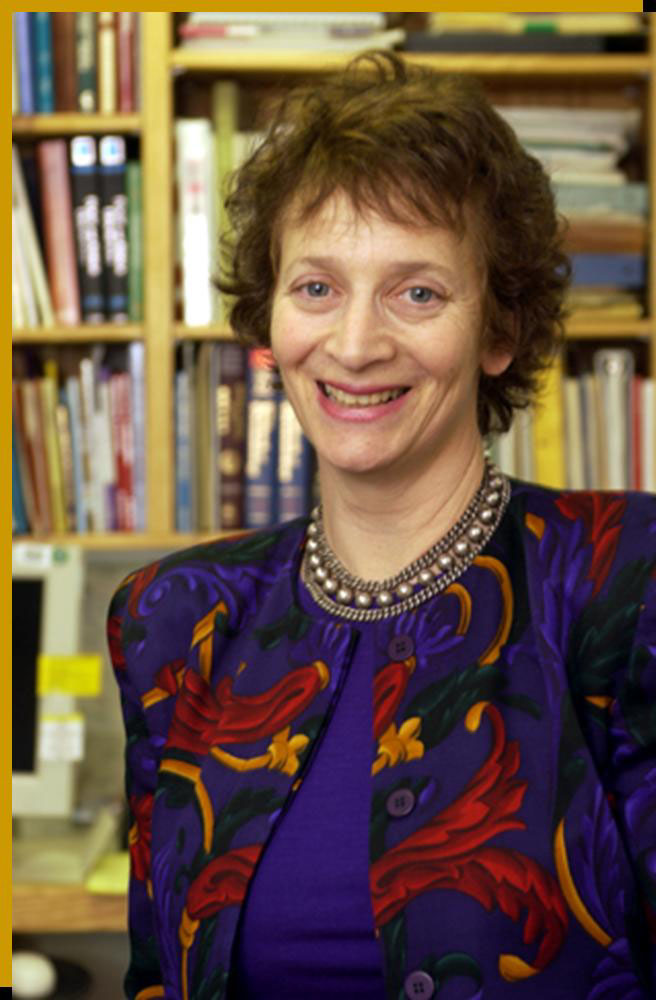 |
Dr. Lynn Gerber
|
Gerber’s first personal memory of NIH comes from her time as a summer research fellow in Nobel Prize winner Dr. Marshall Nirenberg’s lab in 1962. “I had volunteered to work for weeks or months, unpaid if need be, just to work with anyone who needed an extra pair of hands,” she says. “I was working with the who’s who of biomedical research,” she recalls. “It was one wonder after another! After that life-changing experience I decided, ‘I have to do something with my life. I have to fashion my life in such a way that I can, in one way or another, work in an exciting area.’” That personal goal would be fully realized almost a decade later.
After completing her undergraduate work at Smith College, her medical degree from Tufts University School of Medicine and her residency at the New England Medical Center, Gerber joined NIH as a clinical associate in the arthritis and rheumatism branch of the National Institute of Arthritis, Metabolism and Digestive Diseases (now the National Institute of Arthritis and Musculoskeletal and Skin Diseases, NIAMS) in 1973, where she completed her fellowship in rheumatology.
Many individuals at NIH took note of Gerber’s tenacity and dedicated work ethic. One of those people was Roger Black, acting director of the Clinical Center at the time Gerber was working in NIAMS. He was looking for someone to take on the role of chief of the Clinical Center’s Department of Rehabilitation Medicine and decided Gerber was the woman for the job. She began a residency in physical medicine and rehabilitation at George Washington University Medical Center in 1975 and stepped into the role of chief in 1976.
Her tenure in the department has not only changed how rehabilitation medicine interacts with other departments and clinical studies at NIH today, but it has also blazed a scientific trail in developing ways to measure a patient’s quality of life following a diagnosis or treatment. When she first took the helm at rehab medicine, Gerber asked the question—what makes a treatment successful? At the time, the answer from many scientists was that success was defined by whether the patient died or lived. However, Gerber proposed the concept of judging success not solely on the factor of mortality, but also function and valued life activities, even if measured subjectively.
“At the time, Dr. Steven Rosenberg, chief of the surgical oncology branch at NCI, was conducting a study on sarcoma (a solid tumor of the extremities),” Gerber says, “and he was trying to determine which treatment, amputation or a limb-sparing procedure, would result in better prognosis. But my question was, how could one decide without measuring functional parameters? We helped them assess function (limb swelling, insensitivity, time to return to usual activity), which helped realign their original surgical plan.”
Dr. David Henderson, deputy director for clinical care, said of Gerber at her retirement party, “She has been unbelievably invested in this organization and we are losing one of our real pillars of this community.”
As a result of the partnerships with institute collaborators, there was support for something she never expected—a clinical laboratory. “In the mid-1980s we were able to install a lab of biomechanics to study human motion. Today that lab is located on the first floor of the Hatfield Center.
“We have applied existing outcome measures and devised new instruments to meet the needs of the investigation,” Gerber explains. “We can measure muscle strength, mobility and activities of daily living with a great degree of sensitivity and tell what is effective and what is not.”
Gerber has put her knowledge to good use through such unique offerings as the foot clinic, which she started in 1995. The clinic brings together an average of ten other specialists who will meet with one patient at a time, analyze the problem, and brainstorm ideas to come up with the best remedy.
“Dr. Gerber listens carefully to what patients have to say,” says Karen Siegel, a physical therapist and senior staff specialist in the rehab medicine department. “Her patients feel that their functional level and quality of life is the result of the care she has provided them.”
Many of the diseases Gerber and her colleagues treat are chronic conditions, which means Gerber and her patients often form lifelong friendships. Many of her osteogenesis imperfecta patients have been coming to Gerber’s lab since they were infants. She knows each of them by name and talks of their various accomplishments like a proud mother.
“The best rewards of my work are when you see people not just surviving, but surviving well,” Gerber says. “I don’t focus on treating the disease. I am concerned with their potential for restoring function. We rehabilitationists believe there is much we can do to help patients solve problems so that they can do more and do more of what they would like. We add life to years.”
Gerber applies the rehab philosophy to herself as well. One of her former patients became her tennis instructor, getting Gerber back in the game after years of not picking up a racket, and now she plays competitively in the local circuit. “I believe in rehabilitation medicine because I see what people can do for themselves. As you age, accelerate. Don’t slow down.”
Clearly, Gerber has no intention of slowing down. For her, retirement is simply the next step toward helping a population in need.
Gerber said to the gathered group of friends and colleagues, “Coming to NIH was the fulfillment of a dream. Not only when I arrived, but every step along the way. I am truly grateful for all you have done to help in this cause and for all the support for and confidence you have had in me. Thank you.”
Back to Top
Dr. Wilson named new chief of pharmacy
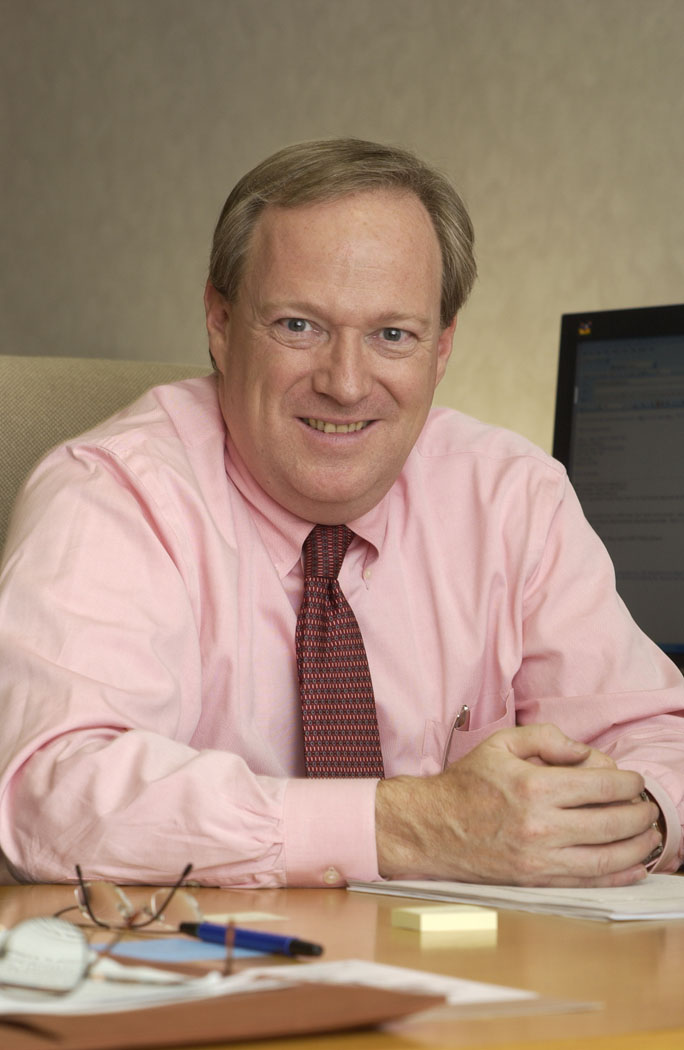 |
|
Dr. Andrew Wilson, new chief of the CC Pharmacy Department
|
By John Iler
Dr. Andrew Wilson was named new chief of the CC Pharmacy Department in October. He had directed pharmacy services at the Medical College of Virginia Hospitals (MCV) in Richmond since 1998. During that time he also served as associate dean for institutional programs and associate professor of pharmacy practice in the Virginia Common-wealth University School of Pharmacy.
“Dr. Wilson has extensive experience with pharmacy cost-containment strategies, implementation of new pharmacy electronic information systems and implementation of automation and robotics,” noted Dr. John I. Gallin, CC director, in making the announcement. “This expertise will serve him well in his new role at the Clinical Center.”
At MCV Wilson led the professional, clinical, operational and administrative pharmacy for a 700-bed teaching hospital, including its ambulatory clinics, a home-infusion and specialty-services pharmacy and four large outpatient pharmacies. He managed a staff of 160 employees, an expense budget of $53 million and a revenue budget of $116.5 million. Previous to his MCV appointment, he served 10 years as the director of pharmacy services at Saint Louis University Hospital in Missouri.
Now he’s anxious to be a part of the Clinical Center’s professional legacy.
“That legacy is why I’m here,” he says. “When you think of what this job entails, it’s a 360-degree approach. There’s patient care, research and customer service. It’s about meeting a professional standard that is second to none. It’s also about becoming part of the most prestigious group of medical researchers, practitioners and caregivers in the world. Am I excited? Yes, I wouldn’t be here if I weren’t!”
Wilson’s dedication to his work is reflected in his numerous recognitions and contributions to pharmaceutical health and clinical care. In 1996, he was named a fellow of the American Society of Health System Pharmacists. Participating on several editorial boards for national pharmacy publications, he maintains an active interest in the education and training of pharmacists.
“Everything I’ve done has involved a multifaceted approach,” he said. “Cost-containment strategies, the implementation of new pharmacy electronic information systems and, with the implementation of automation and robotics—are all significant technical advances with which I have had experience. But that’s only part of it. These technologies all have to be integrated with the basic recognition that the ultimate driver is people. And my opinion is, NIH clinical care, which is people-based, has always been a step above the rest.”
Wilson succeeds Dr. Chuck Daniels, now associate dean of the School of Pharmacy and Pharmaceutical Sciences at the University of California, San Diego. Bob DeChristoforo served as the department’s acting chief for the past year.
Back to Top
Young fans keep Maryland Terps coming back
By John Iler
When word got out that there were some Terrapins fans in the Clinical Center’s pediatric unit, the University of Maryland baseball team decided to come meet with the young baseball aficionados. After just one visit, the patients found themselves with more than just a few signed baseballs—they had earned a fan club of their own. This special relationship between the “Terps” and the pediatric patients has become, as they say on the field, a hit.
Capt. Paul Jarosinski, a Commissioned Corps officer and a pediatric clinical pharmacist in the Clinical Center, was a key player in getting the team in touch with the pediatric unit. Jarosinski’s son, Brian, is a student at the University of Maryland, where he also plays as an outfielder for the Terps.
The Terps personnel, dressed in their shirts and caps, sporting boxes of goodies, spent some time in the old playroom on the fourteenth floor of the Magnuson Center on the first of two visits so far.
“This has been so good for many of the patients,” recreation therapist and event organizer Kristen Johnsen says. “Many of them are here for extended periods and it’s a good break in their routine. You can see it in their faces when they get an autographed ball and talk to actual players. It’s very exciting, even for me!”
“One patient just happened to be a baseball standout with significant potential to be a player himself before he got sick,” Jarosinski says. “He waited for the guys, and when they arrived he talked to them some time about his own experience.”
A few others had considerable baseball interests, while most were just happy to get caught up in the excitement of college baseball.
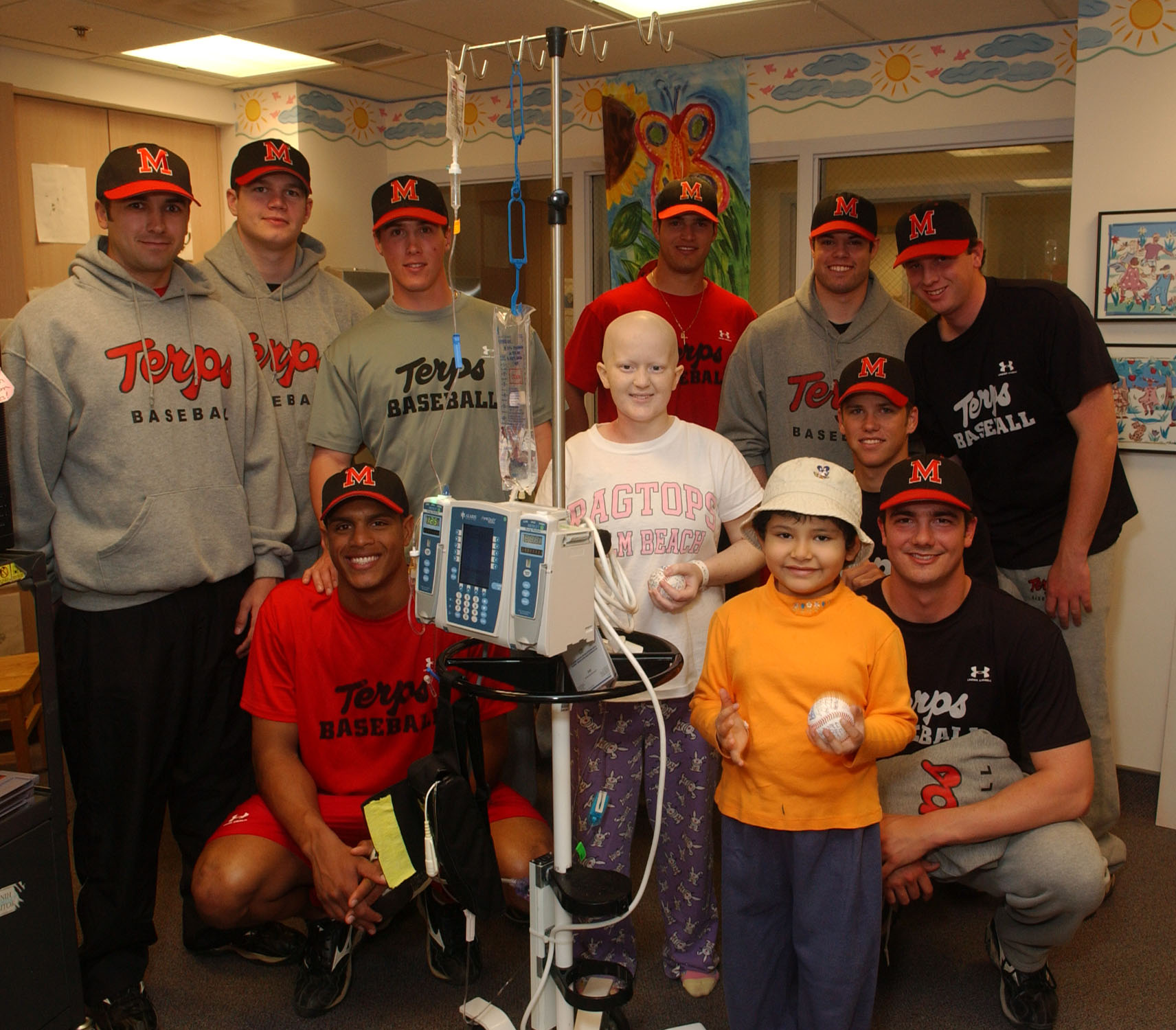 |
|
The Maryland Terrapins baseball team with pediatric patients Amy Knopfmacher (left) and Valeria Rivero, on one of their CC visits.
|
“Our players really enjoyed the opportunity to visit with the young patients and we’d like to come back and visit again,” says head coach Terry Rupp. “We’d also like to invite as many as can attend to be our guests at our games because many of us want so much to give something back to the community. We look forward to continued relations with the hospital and patients.”
Assistant coach Carmen Carone agrees. “It was a great experience! I think this is the first time the guys had visited a hospital in the area and I believe they had a wonderful time. Some told me it was great just to brighten the day of folks that are going through a tough time.”
As for Jarosinski, the experience was a great success. “Seeing the faces of the kids light up at the opportunity to see these guys up close and take an autographed baseball or poster right from their hand—there are no words to describe it,” Jarosinski says. “There was one youngster who was racing through the hallways and into one room after another to show off his baseball and telling everyone he was going to save that ball for the rest of his life.”
“The funny thing,” says Jarosinski, “is that I think the visit was a special moment for the players as well as the patients they visited. We had to restrict the number of players visiting due to space limitations in the patient care areas. However, the team has already requested to make future visits bringing players who could not previously make it.”
Back to Top
Dr. Art Atkinson retires from Clinical Center
Dr. Arthur J. Atkinson, senior advisor in clinical pharmacology to the CC director, is retiring from NIH after eight years at the Clinical Center. His relationship with the organization dates back to 1965 when he worked in NIAID as a clinical associate.
In 1997, he served as a special expert consultant for the National Institute of General Medical Sciences and was charged with assessing NIH’s proposed intramural training program in clinical pharmacology. After completing his study as a consultant, he was offered the position he holds today, directing the ClinPRAT postdoctoral training program and the Clinical Center course on Principles of Clinical Pharmacology.
“I wanted trainees to have the same wonderful experience I had as a clinical associate,” Atkinson says.
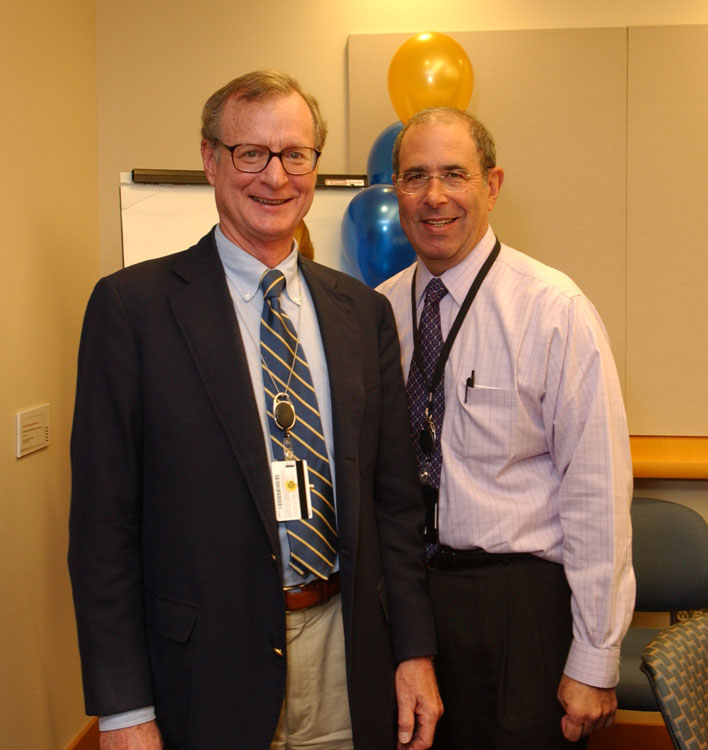 |
|
Dr. Arthur Atkinson (left), with CC director John I. Gallin, retires from NIH after leading the ClinPRAT program for seven years.
|
Under his leadership, the program has seen an increase in enrollment from 180 students to 500, a series of 34 lectures, a web site created to provide access to syllabus materials and videotapes of the lectures. Today the program is televised coast to coast and is broadcast in classrooms at University of California, Los Angeles, Indiana University and University of Texas Southwestern Medical Center.
In March 2005 Atkinson joined the ranks of Nobel Prize winners and other leading clinical thinkers when he was awarded the Oscar B. Hunter Memorial Award in Therapeutics from the American Society for Clinical Pharmacology and Therapeutics (ASCPT) for his work in applying mathematical principles to individual drug therapy and dosage. “It was very humbling to receive the award,” he says. “Some of these names are giants and their accomplishments are not likely to be equaled.”
After completing his A.B. degree in chemistry from Harvard College, his medical degree from Cornell University Medical College and postdoctoral training in clinical pharmacology at the University of Cincinnati, Atkinson began a distinguished career as both an academic and scientist. He worked as a visiting scientist in the Department of Toxicology of the Karolinska Institute in Sweden before moving to Northwestern University Medical School in 1970 to start the program in clinical pharmacology, and later was appointed corporate vice president for Clinical Development and Medical Affairs at the pharmaceutical giant—Upjohn Company.
Back to Top
Clinical Research Curriculum Program adds new course and online tracking system
Designed for clinical fellows, senior physicians, staff clinicians, investigators, dentists and other health-care professionals at NIH, the Clinical Research Curriculum Certificate Program, administered by the NIH Clinical Center, is a unique offering for those individuals engaged in, or planning to become involved with, clinical or translational research.
The curriculum program features the core competencies of clinical research and has four key requirements, including general principles and bioethical issues.
“The courses are freestanding,” explains Dr. Frederick Ognibene, director, CC Office of Clinical Research Training and Medical Education. “By packaging the core clinical research competencies as a certificate program based on a curriculum, we are acknowledging an individual has completed the educational experience.”
Since it was established in 2003, the Clinical Center Office of Clinical Research Training and Medical Education has focused on providing high quality clinical research training. With distance-learning capabilities currently offered in addition to on-site education, the office continues to equip medical professionals with the skills and knowledge necessary to serve effectively in their roles as clinician-scientists.
Ten NIH physicians and health professionals have received their certificates since the program’s inception, including: Linda Griffith (NIAID), Yukitaka Shizukuda (NHLBI), Jan Preiss (NIAID), Shayam Kottilil (NIAID), John Lynch (NINDS), Joyson Karakunnel (NIDCR), Nancy Bowen (NINDS), Meena Iyer (NINDS), Markus Ries (NINDS), and Bryan Traynor (NIMH).
“The skills learned in the program are not unique to investigators at NIH,” Ognibene says. “Those skills could and should be transported to another location if that individual leaves to work elsewhere.” Karakunnel was one such program graduate who left NIH to participate in a hematology/oncology fellowship at the University of Maryland. “My long-term goals include working in an academic setting and conducting phase 1 trials in oncology,” he writes. “The Clinical Research Curriculum Program certificate has helped me to further my education by providing me with an advantage in clinical research.”
This year, the certificate program will offer two new resources. The first, an online tracking system, will allow applicants to register online and monitor their progress in completing the requirements. The system will collect information over time as the mandatory and supplemental components of the program are completed and inform participants when they have satisfied the certificate requirements.
The second resource is a new web-based training course that represents a collaboration between the Food and Drug Administration, NIAID and the Clinical Center. The course, “Introduction to the Regulatory Process for Clinical Investigators” is an elective in the certificate program and is scheduled for implementation by late November. Both resources will be located on the program’s intranet site at http://intranet.cc.nih.gov/ clinicalresearchtraining/curriculumcert.shtml.
For more information on the Clinical Research Curriculum Certificate Program, call (301) 496-9425 or visit http://intranet.cc.nih.gov/clinicalresearchtraining.
Back to Top
Nurse Priscilla Rivera retires after 32 years at NIH
By Louise Canada, Nurse Historian, Nursing and Patient Care Services
The Clinical Center nursing department bid farewell to Priscilla Rivera, nurse manager of 3NE, hematology/ oncology/transplant unit, as she retired in November.
Rivera is well known at NIH where she has served as a staff nurse, clinical nurse expert, head nurse and nurse manager during her 32 years here.
Rivera was born in Puerto Rico and grew up in New York City. She obtained her associate degree in nursing from the Bronx Community College in 1968. In the years following, she worked in New York, California and Puerto Rico and eventually found her home at NIH in 1973 when she began her civil service nursing career as a staff nurse in the lipid/hematology/pulmonary unit.
As she continued to expand her education, her responsibilities at NIH grew as well. She earned her BSN and a master’s degree in medical nursing from the University of Maryland and a certificate in public administration from American University. Through the years, she worked as a staff nurse, clinical nurse expert in the CC cardiac surgery intensive care unit and head nurse for 7 West, 8 East and the NHLBI outpatient clinics. She assumed the role of nurse manager for 2 West/BMT units in 1995 and nurse manager for 12 East medical oncology/transplant unit for NCI in 2003 and helped with the move from the Magnuson building to the new Hatfield Center. Rivera most recently worked as nurse manager of 55 professional nurses on the new hematology/oncology/ transplant unit of 3NE.
Rivera has presented lectures at oncology and Hispanic conferences and is published in three nursing journals as well as the textbook Medical-Surgical Nursing. She has been a primary and associate investigator on two nursing research studies and has received more than 23 honors and awards at NIH. She has been a member of and secretary for the Washington, D.C., chapter of the National Association of Hispanic Nurses, a member of the American Nurses Association, the Maryland Nurses Association, the Oncology Nursing Society and Sigma Theta Tau.
Rivera plans to enjoy retirement by spending more time traveling, exercising and reading.
Back to Top
In memoriam: Susan Biddle leaves legacy of laughter
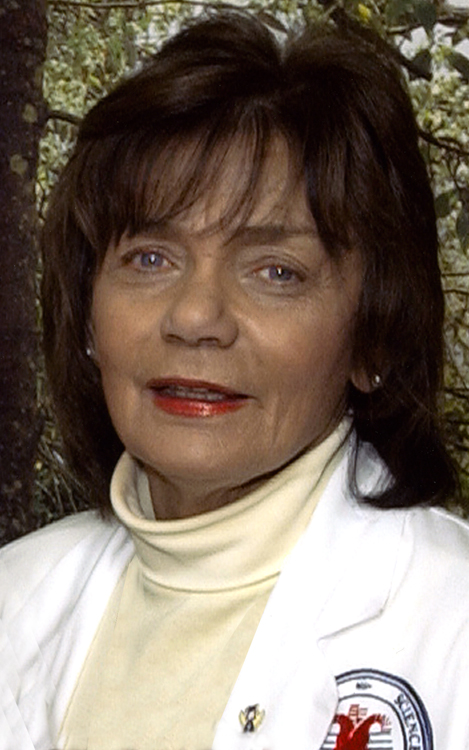 |
Nurse Susan Biddle of OP7
|
Susan Biddle, a registered nurse assigned to OP7, died suddenly on September 28.
“Susan Biddle joined our staff about three years ago, and from the outset she brought brightness, wit, intelligence and genuine caring to her interactions with staff, patients and family members,” said Awilda Holland, Biddle’s supervisor. “She had been a devoted and valued employee of NIH for more than 20 years by then and had a solid reputation as a compassionate nurse who was committed to the mission here at NIH.”
“This is a life that ended too early,” said OP7 nurse Diane Vollberg. “Susan had the innate ability to look at a patient and sense what was wrong with them. She taught us many things, was our mentor, our inspiration and our friend.”
Said colleague Dr. Dorothea McAreavey, critical and acute care services, “As a nurse, Susan was compassionate and always ready to help when someone needed her. Patients were the focus of her professional life. With her great understanding of medicine and nursing, she always seemed to know the needs of patients as individuals.”
“She was the first one I saw in the morning and the last person I saw when I left each night,” said clerk Ron Kuster. “She had a vast knowledge that caused her to bring a special twist to every situation. She was a comic, with a sharp wit. She knew all the rules and served as an example.”
Fellow nurse Angela Kokkinis worked with Biddle since her friend arrived at OP7. “She had a wicked sense of humor and made us laugh,” Kokkinis said. “She brightened the day for both the staff and the patients. My heart is a little heavier now when I come to work.”
Biddle’s intuitive ability to size up patient needs, both physically and psychologically, never ceased to amaze those with whom she worked.
“Over the years, so many patients passed through the halls of the Clinical Center, but it was always Susan they asked for if they came back,” said Fran Loscalzo, special assistant chief of ambulatory care. “What I miss most about her is commitment, dedication and devotion to the nursing profession, as well as her ability to combine humor with that devotion.”
Biddle, who held a MSN degree, was named Nurse of the Year by OP7 in May.
Back to Top
News Briefs
NIH-Duke Training Program in Clinical Research
Applications are being accepted for the 2006-2007 NIH-Duke Training Program in Clinical Research. The program is designed primarily for physicians and dentists who desire formal training in the quantitative and methodological principles of clinical research. Courses are offered at the NIH Clinical Center via video-conference and academic credit may be applied toward a Master of Health Sciences in Clinical Research from Duke University School of Medicine. The program, designed for part-time study, requires 24 credits of graded course work, plus a research project for which 12 units of credit are given. Additional information regarding coursework and tuition costs is available at http://tpcr.mc.duke.edu or by e-mail at tpcr@mc.duke.edu. The application deadline is March 1 and space is limited.
Clinical trials seeking volunteers
NICHD is seeking healthy volunteers, ages 18-30, to participate in an investigational anthrax vaccine study conducted at the NIH, DHHS. Medical tests will determine eligibility. Compensation provided. Please call 1-800-411-1222 (TTY: 1-866-411-1010). www.cc.nih.gov Study 04-CH-0283.
Research Malaria Vaccine Study Doctors at the NIH are conducting a study to test the safety of a research malaria vaccine and its ability to generate immunity. Males or non-pregnant females, healthy, between the ages of 18 and 50, and who have never been exposed to malaria may consider participating. All study-related-tests and medicines are provided at no cost, and you are compensated. The research vaccine will not infect you with malaria. Call 1-800-411-1222 (TTY# 1-866-411-1010). The NIH is part of DHHS. Refer to study 05-I-0133.
Thyroid Research for volunteers 18 or older with thyroid gland removed and taking thyroid replacement therapy. The study will look at how the body uses thyroid hormones to control the rate of body functions. There is no cost for the research tests or treatment. Compensation is provided. NIH, part of DHHS. Call: 1-800-411-1222 (TTY: 1-866-411-1010) or visit http://clinicaltrials.gov. Se habla español. (Study 05-DK-0119)
Help Build Better Vaccines for a Healthier World A new generation of science building a new generation of vaccines. Healthy adults 18-50 years old needed to participate in the study of an investigational West Nile Virus vaccine. Financial compensation is provided. These studies are being conducted by the Vaccine Research Center, National Institute of Allergy and Infectious Diseases, NIH, DHHS www.cc.nih.gov Study 05-I-0126 To volunteer, or for more information, please call us at 1-866-833-LIFE (toll-free) or TTY 1-866-411-1010.
Jet Lag NIH researchers are looking for travelers going east 6-8 time zones to study the effects of replacing hormones disrupted by jet travel. Participants will take a study medication (hydrocortisone, melatonin, or placebo), fill out questionnaires and obtain salivary samples. Travel stay of 4-10 days at destination required. Time involved will include one screening visit and blood work and one follow-up visit. Healthy adults, ages 18-65 call 1-800-411-1222 (TTY: 1-866-411-1010). NIH is part of the DHHS (Study 05-CH-0037)
HIV+ Volunteers off anti-HIV-medications, CD4+ 350 or greater, without Hepatitis B or C, needed for research study at NIH, part of the DHHS. Financial compensation provided. 1-800-411-1222 (TTY 1-866-411-1010). (Study 05-I-0065)
The NIH invites you to participate in a clinical study to learn more about ovarian function. Information obtained from this study will be used to develop a test that will enable physicians to uncover various kinds of ovarian dysfunction early in a woman’s life. Women 18 to 25 years of age call 1-800-411-1222, or TTY 1-866-411-1010, for information. Study-related tests or treatment are provided at no cost. Participants will be compensated. The NIH is part of the DHHS. Study 00-CH-0189.
Healthy Volunteers Platelets are blood cells that help to stop bleeding. People with abnormal or missing platelet sacs tend to bleed longer than other people. NIH doctors are conducting a study to examine how platelet sacs are formed and what happens to cause bleeding disorders. Study results may contribute to the medical care, treatment, and prevention of problems associated with this disorder. If you have been diagnosed with abnormal platelets, call 1-800-411-1222 (TTY: 1-866-411-1010). NIH is part of the DHHS. Study 04-HG-0226.
Healthy African Americans and Africans with low white blood count needed! You can help us at NIH understand why individuals with low white blood count remain healthy. Call us at 1-800-411-1222 (TTY#1-866-411-1010) refer to study # 03-DK-0168 NIH is part of the DHHS Compensation available.
HIV+ Volunteers off anti-HIV-medications, CD4+ 350 or greater, without Hepatitis B or C, needed for research study at NIH, part of the DHHS. Financial compensation provided. 1-800-411-1222 (TTY 1-866-411-1010). (Study 04-I-0018)
If you are 30 to 80 years of age and are diagnosed with Parkinson's disease, you may qualify for our Parkinson's disease study. No charge for study-related tests or treatments. Travel assistance is available. For more information call 1-800-411-1222 (TTY# 1-866-411-1010). The NIH is part of the U.S. Department of Health and Human Services.
Asthma Study for children ages 5 to 17. This study will evaluate the usefulness of a new procedure for evaluating asthma in children. All study related tests will be provided at no cost. Compensation provided. The NIH is part of the Department of Health and Human Services. For more information: 1-800-411-1222 (TTY# 1-866-411-1010). Se habla espanol.
Holiday fundraiser cancelled
The Department of Laboratory Medicine (DLM) staff announce that the annual DLM Holiday Auction is cancelled. The recent revisions in conflict of interest rules have resulted in more careful scrutiny of all activities involving NIH facilities and DLM has concluded that holding the auction cannot be done in compliance with these regulations. DLM thanks all NIH staff who have participated in prior auctions and wish all a happy holiday season.
New Equal Employment Opportunity (EEO) contact for CC employees
As a result of the restructuring of the NIH Office of Equal Opportunity and Diversity Management (EODM), the former Clinical Center EEO Office has been closed and consolidated into the EODM. Andre Smith is the new contact for Clinical Center employees—a post previously held by Carl Lucas. “Employees can come to me with any concerns they may have,” Smith says. To reach Andre Smith, call (301) 451-0854. His office is located in Building 2, Room 3E13.
Back to Top
November 2005 Upcoming Events
|
November 15 (Tuesday)
3 p.m. Masur Auditorium
NIH Director’s Lecture
From the Bedside to the Bench and Back Again: To Understand, Treat and Prevent HSV and VZV Infections
Stephen E. Straus, MD, Director, NCCAM; Senior Investigator, Laboratory of Clinical Infectious Diseases, NIAID
November 16 (Wednesday)
Noon–1 p.m. Lipsett Amphitheater
Grand Rounds: When Should Pregnancy Be an Exclusion From Clinical Research?
Bonnie Steinbock, PhD, Professor of Philosophy, University at Albany, State University of New York
November 16 (Wednesday)
3 p.m. Masur Auditorium
NIH Director’s Lecture— The Khoury Lecture
How DNA Viruses Deal with Stress
James C. Alwine, PhD, Professor, Department of Cancer Biology; Investigator, Abramson Family Cancer Research Institute; Associate Director, Abramson Cancer Center; Chair, Cell Growth and Cancer Graduate Program, School of Medicine, University of Pennsylvania
November 17 (Thursday)
Noon–1 p.m. Hatfield Center Atrium
Fall Music Series at the Oasis
Premier, Women’s Gospel and Acapella Music
November 30 (Wednesday)
Noon–1 p.m. Lipsett Amphitheater
Grand Rounds: Challenging Cases From Multiple Specialties
James E. Balow, MD, Clinical Director, NIDDK
November 30 (Wednesday)
3 p.m. Masur Auditorium
NIH Director’s Lecture
Remodeling Proteins and the Proteome by AAA+ ATPase Machines
Tania A. Baker, PhD, Whitehead Professor of Biology and HHMI Investigator, Massachusetts Institute of Technology
December 7 (Wednesday)
3 p.m. Masur Auditorium
NIH Director’s Lecture
T Cells and MHC
Philippa Marrack, PhD, Investigator, HHMI; Professor, Integrated Department of Immunology, National Jewish Medical and Research Center and University of Colorado at Denver Health Sciences Center
December 7 (Wednesday)
Noon Hatfield Center Atrium
Holiday Concert Series
St. Albans Bell Ringers
December 8 (Thursday)
7 p.m. Hatfield Center Atrium
Holiday Concert Series
Washington Chorus
December 9 (Friday)
1–3 p.m. Masur Auditorium
Clinical Center Director’s Annual Address and Awards Ceremony
Reception following the ceremony
December 12 (Monday)
12:30 p.m. Masur Auditorium
Manchester String Quartet at NIH
Made possible by the Merck Company Foundation
December 13–15 (Tuesday–Thursday)
Hatfield Center Atrium
Gingerbread House Decorating Contest
The houses will be displayed in the atrium and there will be a ballot box next to each one for patients, visitors and staff to cast their votes for the favorites.
|
Back to Top
Photo of the Month
Kiddie Cruisers come to the CC
Pediatric patient Lindsay Ratcliffe displays her “no hands” driving talent for her mother. Lindsay is one of the many young riders who take advantage of the Clinical Center’s new kiddie cruisers, which provide parents a fun and safe way to transport their children throughout the Clinical Center.
Offered through hospitality services, the kiddie cruisers include three NIH red cars, which seat one child, and three NIH yellow schoolbuses that seat two. They are available in the pediatric unit as well as from the main hospitality desk on the first floor of the Hatfield Center.
Each is equipped with a storage place for personal belongings as well as an IV pole if a patient needs to travel with an IV.
“They are used steadily,” says Denise Ford, CC chief of hospitality services. “People’s faces brighten up when they see them.”
Back to Top
|
|
Clinical Center News, National
Institutes of Health, Building 10, 10 Center Drive, Room 12C440, Bethesda, MD 20892-1504. Tel: 301-496-6787.
Fax: 301-402-2984. Published monthly for CC employees
by the Office of Communications, Patient Recruitment, and Public Liaison. News, article ideas,
calendar events, letters, and photographs are welcome.
Back to Top
|
|


